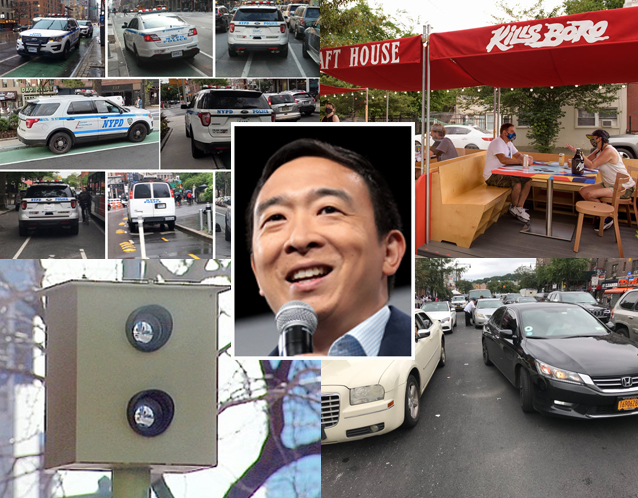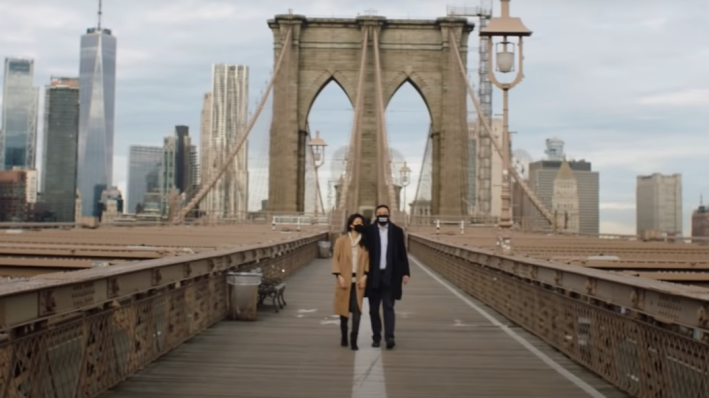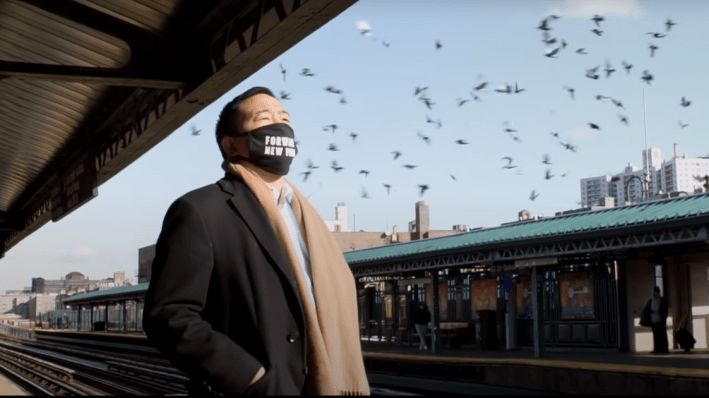DECISION 2021: Andrew Yang Answers Streetsblog’s Candidate Questionnaire
12:01 AM EST on February 5, 2021

Andrew Yang — entrepreneur, technology evangelist, philanthropist and not-for-profit leader — entered the contest for New York City mayor recently after amassing a passionate following, the "Yang Gang," during a Quixotic, but surprisingly robust, dark-horse presidential run. Last month, Streetsblog extended to his campaign the opportunity to answer our candidate street-safety questionnaire, which was filled out earlier by 10 Democratic candidates (Ray McGuire and Sara Tirschwell, a Republican candidate, have declined to participate.)
For a general recap on earlier installments in our series, click here. To review all the candidates' answers to all the questions, click on the topics of your particular interest:
And now, presenting Andrew Yang (with annotations referring to our prior coverage):
The Open and Restaurant Streets programs repurposed curbside space for public use instead of the free storage of privately owned cars. Would you make such programs permanent — and do you have other ideas for repurposing street space for public benefit?

YANG: I would make the Open and Restaurants Streets programs permanent. We saw how integral these programs were during the pandemic and how much more use these spaces get when public land is not used for free car storage. We’ll also pursue land swap options for restaurants who have physical impediments in front of their storefronts.
We need to be far more aggressive in repurposing street space for all New Yorkers. I want to rapidly expand Bus Rapid Transit, I want to pedestrianize additional streets beyond the open streets implemented during COVID, and I want far more protected bike lanes that are truly protected. I also think curb parking spaces should be used for centralized trash pickup and have designated areas for freight and trucking purposes.
Here Yang embraces the consensus position of the 10 candidates Streetsblog surveyed earlier, who all endorsed Mayor de Blasio’s plan to enshrine permanently the Open Streets and Open Restaurants programs, which started as COVID-relief measures. He makes the right “noise” when he calls parking “free car storage” and endorses other curbside uses such as centralized trash receptacles and residential loading zones, but he doesn’t offer many specifics, as did others who have been in the contest longer, such as Shaun Donovan and Scott Stringer. He also doesn’t connect the reclaiming of streets to larger social-justice goals.

New York City has an estimated three million free parking spaces. Do you support metering them in order to create a permanent revenue stream? If so, would you dedicate that money, in a lockbox, for transit and/or streetscape improvements?
YANG: I do support expanded metered parking, particularly in and around commercial districts. The amount of free parking has to be curtailed. However, with the city’s budget in flux, I don’t believe it makes sense to create such a lockbox with revenue for metered parking at this point. Our whole administration will be oriented around anti-poverty ideals and making our mass-transit system world class, particularly if and when we achieve municipal control of our subways and buses.
Yang dodges the question here, offering vague nostrums when other candidates, such as Carlos Menchaca (who has advocated for removing a million parking spaces) and Stringer. But his proposal for municipal control of the subway and buses intrigues; City Council Speaker Corey Johnson was running on this idea until he dropped out of the race. Yang is bold to pick it up.
Do you support a private-car-free Manhattan and if not, why not?
YANG: As an avid biker — for commuting and recreational purposes — who lives in Manhattan, I know how great creating far more street space for uses other than private car traffic would be for residents and visitors here. I believe we can reduce the influence of private cars in Manhattan so that our public space better serves a public purpose. I was thrilled to see the recent announcement about new bike lanes on the Brooklyn and Queensboro Bridges.
To that end, I intend on moving toward a far more pedestrian-, bike-, and mass transit-friendly Manhattan. Rethinking Broadway and the area around Ground Central are particular projects I think are essential for reinvigorating street life and helping the city’s recovery. I also want to expand Bus Rapid Transit in key corridors in Manhattan (as well as in the other four boroughs, of course). The 14th Street Busway is a huge success and we should quickly replicate it elsewhere. In addition, I want to reform the placard program so we can reduce placard abuse. And I also support implementing congestion pricing as soon as possible so that we can further reduce the dominance of private cars in Manhattan and get the necessary funding to our mass-transit system.
The “car-free Manhattan” question provoked the sharpest line-drawing among the 11 candidates Streetsblog now has surveyed. Menchaca, Stringer and Loree Sutton all gave full-throated support for the idea. Yang’s answer puts him closer to Donovan and Eric Adams, who support expanded car-free zones but wouldn't buy into a more expansive vision. Props to Yang for stressing congestion pricing and the need to rein in placard abuse, however — those are two things that will be crucial to any Manhattan solution.
What have you done in your career to get reckless drivers off our streets? Please be very specific.
YANG: We moved in the wrong direction this year in terms of street safety. Vision Zero is an admirable goal, but it hasn’t worked as of late. I want to expand speed cameras so they are turned on 24/7. I want to ensure public-safety officials are investigating car crashes and not letting drivers off the hook. And I want to continue redesigning our streets so that bad drivers have less of an opportunity to be reckless.
Yang the entrepreneur can’t offer any concrete accomplishments in this vein, so he falls back on rhetoric. That’s OK, but he might have made more of his Obama administration connections (he was an Obama "Champion of Change") in making the case that he has the tool and knowledge for the task.
🎶Making my way downtown...🎶 pic.twitter.com/6LhEvAPyux
— Yang for New York (@YangforNY) January 27, 2021
Do you promise not to take campaign money from automobile or fossil-fuel interests?
YANG: Our campaign has already received thousands of donations from New Yorkers and beyond who are excited by our anti-poverty, fact-based campaign and mission. We are not taking money from corporate PACs or registered lobbyists at lobbying firms and we are taking part in the public-matching system.
This is a version of the stock answer supplied by most of the other candidates to this question. Many others, especially Kathryn Garcia, used it to underscore their green bona fides, which would have been more productive than this bland answer.
The NYPD has come under fire for its approach to policing public space, in terms of arresting protesters, exhibiting a racial bias in car and bike stops, and even arresting sellers of churros in the subway. How would you reform the agency’s approach to transportation enforcement? Would you remove the NYPD’s role in traffic enforcement, for example?
YANG: First and foremost, the NYPD’s reaction to the protests this past summer were unacceptable. We need to dramatically change how the NYPD treats protests. The militarization of the police, particularly when responding to peaceful protests, has to be overhauled. I will be amending disciplinary power from the NYPD Commissioner so that an independent oversight body is able to hold officers accountable for misconduct.
I was recently encouraged to see the Department of Consumer and Worker Protection take over oversight of street vendors from the NYPD, just as the Department of Homeless Services took over outreach to unsheltered residents on the subways. Still, switching enforcement to another agency is not a panacea. We need detailed, real-time reporting to know whether enforcement is bias-free and being done appropriately.
We also need to further explore how the NYPD’s role in traffic enforcement can be limited so that we focus on reckless drivers and not biased enforcement based on race.
Yang’s answer here puts him in the middle of the pack. He looks more askance at the NYPD than does Adams — a former police captain — but doesn’t sound a clear racial note except regarding traffic enforcement. That separates him from the left of the field, including Maya Wiley, Isaac Wright and Dianne Morales. Given that even Mayor de Blasio finally acknowledged that the NYPD needs radical reform, and the City Council has introduced legislation to remove the cops from traffic enforcement, we don’t see this language as very strong.

Is there a safety, design or enforcement strategy that is not being deployed that you think is vital to making our roadways, sidewalks and public spaces work better for everyone? How would you promote it in office? (Hint: This is a “visionary” question, so don’t think small.)
YANG: As I said above, I want to expand speed cameras to be on 24/7 and to expand the area they cover. I also want to continue lowering the speed limit throughout the city. We need home rule here. Similarly, we will be installing automated bike-lane cameras to ensure cars do not block the area designated for bikers.
I also will direct the Department of Transportation to follow best practices as outlined by the National Association of City Transportation Officials. How we design our city influences our behavior. If we can do so in a way that doesn’t require law enforcement, I’m all for it.
Last, I will explore and seek to implement the “superblock” concept that is in place in Barcelona. We need to trial this idea and show New Yorkers the benefits of such a streetscape.
This answer shows Yang’s readiness to employ technology in order to solve the city’s problems; his appeal to NACTO, and his citing of the example of Barcelona, demonstrate willingness to look for national and even international models. He’s a technocrat, like Donovan, but without the detailed policy knowledge and government experience. We look forward to seeing more detailed transportation plans from Yang; his website says they are coming soon.
Read More:
Stay in touch
Sign up for our free newsletter
More from Streetsblog New York City
Friday’s Headlines: Canal Street Follies Edition
Manhattan Borough President Mark Levine isn't happy. Plus otherness.
Daylight Again: Bronx Community Board Backs Parking Ban at Intersections
The Boogie Down is down with daylighting!
Community Board Wants Protected Bike Lane on Empire Blvd.
Brooklyn Community Board 9 wants city to upgrade Empire Boulevard's frequently blocked bike lane, which serves as a gateway to Prospect Park.
The Brake: Why We Can’t End Violence on Transit With More Police
Are more cops the answer to violence against transit workers, or is it only driving societal tensions that make attacks more frequent?
Report: Road Violence Hits Record in First Quarter of 2024
Sixty people died in the first three months of the year, 50 percent more than the first quarter of 2018, which was the safest opening three months of any Vision Zero year.




